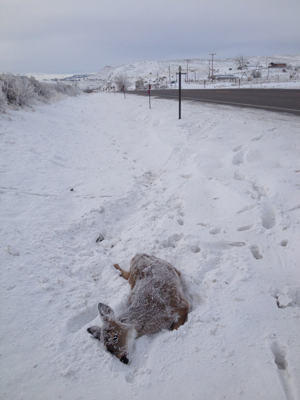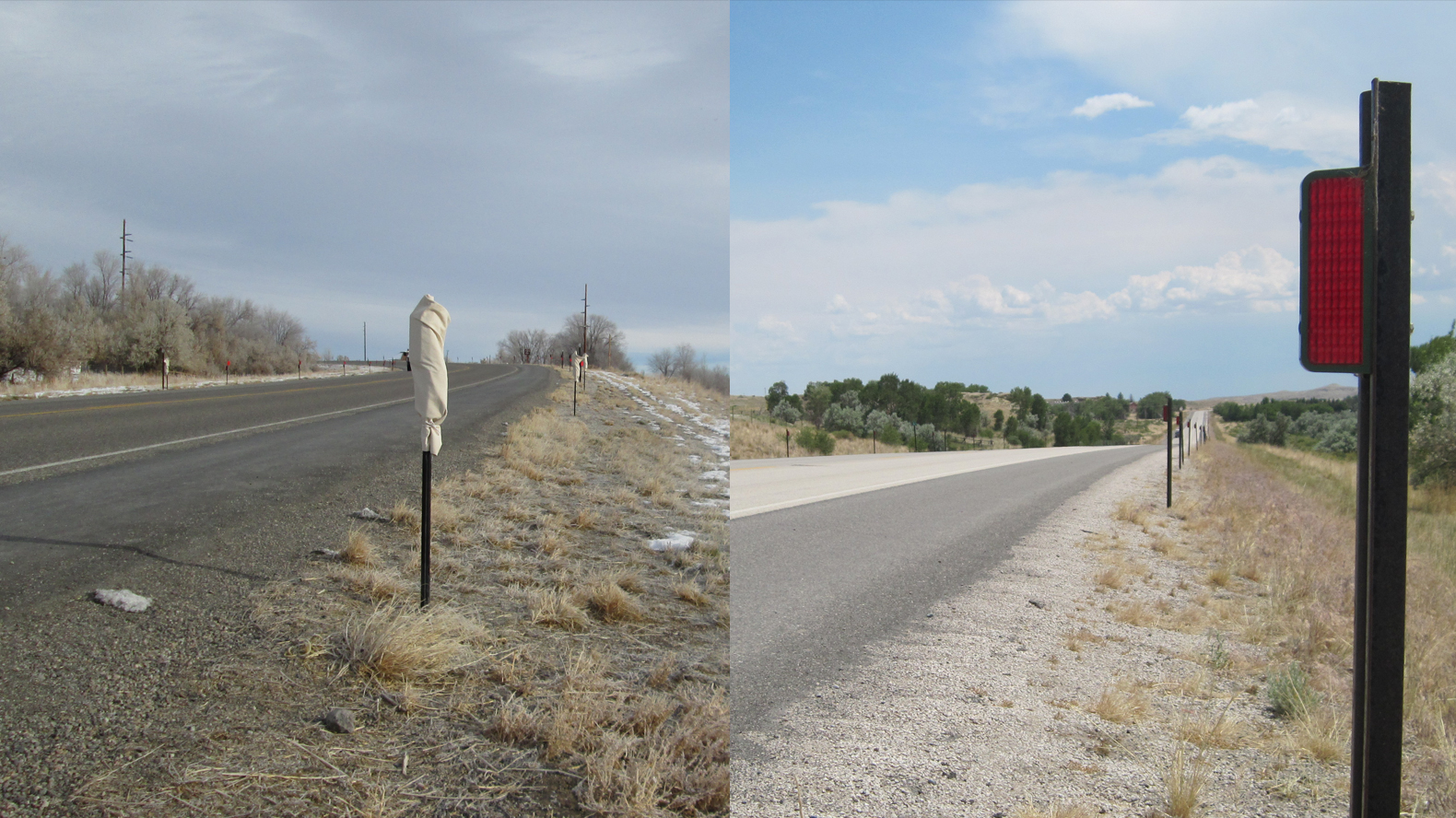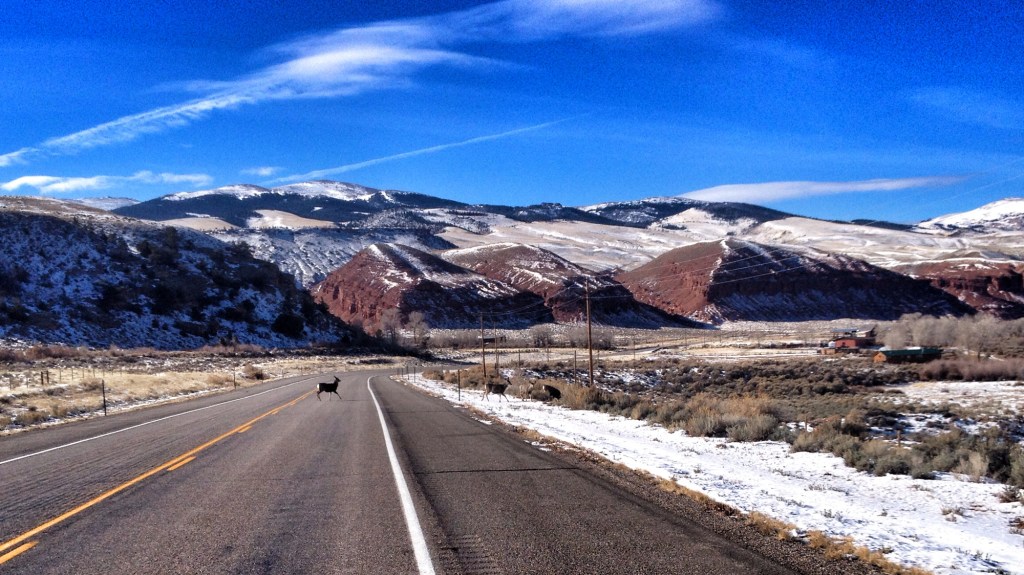Research into the best ways to reduce road deaths of mule deer inadvertently found a new tool that can reduce roadkill: white canvas bags stuck on reflector signs.
These white bags are easy to install and inexpensive. And they may be more effective at allowing deer to cross roads safely than more costly methods.
The study, funded by the Wyoming Department of Transportation, focused on three wildlife-vehicle collision hotspots in Wyoming’s Bighorn Basin. The study was designed to test the effectiveness of wildlife reflectors that are being deployed globally help animals cross roads safely. In the course of testing the reflectors, according to research published in the Wildlife Society Bulletin, researchers found that reflectors covered in white canvas bags as a control were more effective than the actual reflectors.
How Did the Deer Cross the Road?
In the Rocky Mountain West, mule deer and other large mammals still undertake lengthy seasonal migrations from high mountain habitats to lower-elevation sagebrush. The migrations require crossing roads, putting both the animals and drivers at risk.
I live in mule deer country, and every winter see the disturbing carnage along our roads. In many parts of the West, mule deer populations are in decline, and conservationists recognize road deaths as one of the biggest threats. Roads also can cut off migration routes, which can threaten entire populations.
In Wyoming, collisions with deer cause $24 million dollars in damage and injury annually. The economic value of all those dead deer (based on the economic value those deer bring for hunting and wildlife viewing) is another $23 million.

Northcentral Wyoming has an extremely high deer-vehicle collision rate, with some sections of roads averaging 10 to 18 collisions per mile, per year.
When it comes to getting deer (and other wildlife) across the road, the evidence is clear: The most effective methods are wildlife overpasses and underpasses.
“The safest solution for humans and animals are crossing structures that allow animals to cross roads without ever touching the road surface,” says Corinna Riginos, a conservation scientist with The Nature Conservancy in Wyoming, and lead author on the paper.
But such crossing structures are not always feasible. They are expensive, and in some areas geography and development patterns can make them impossible to install.
Testing the Reflector
In areas where wildlife crossing structures aren’t feasible, a number of other methods have been tested. The Wildlife Society Bulletin paper states that many of these – including “deer whistles, olfactory repellents, mirrors, and model deer in alarm posture” – have been proven largely ineffective.
Another method is the use of wildlife-warning reflectors. These reflectors are installed on roadside posts “so that vehicle headlights reflect in a moving pattern both across the road and into the roadside vegetation. The intent is that approaching deer or other ungulates will notice the reflected light and halt or flee away from the road until the vehicle and lights have passed and then cross safely.”
Amidst conflicting studies, conservationists continue to debate the effectiveness of these reflectors. The Wyoming Department of Transportation study sought to determine their effectiveness in areas with high mule deer – vehicle collision rates.
Reflectors were installed along roads. As controls, researchers covered some of the reflectors periodically with white bags and with black bags. The results were surprising. While the reflectors were moderately more effective than those covered with black bags, the white bags were the most effective of all.
In fact, areas with the white bags had 33 percent fewer deer carcass counts than areas with reflectors, and 65 percent fewer carcass counts than areas with the black bags. Essentially, the white bags were serving the same purpose as the reflectors, causing deer to stop or move away from the road. (Researchers also installed video cameras that captured deer reactions). But the white bags, in this study, were found to be more effective.
“We didn’t set out to test the effectiveness of white bags on deer,” says Riginos. “We set out to test the effectiveness of reflectors.”
The white bags are also more cost effective. Wildlife reflectors cost $25 each compared to just $1.50 for a white canvas bag. But Riginos cautions that the bags may not be a long-term solution.
“Will deer get used to the bags and not be as alarmed by them? It’s an open question,” she says. “We don’t know if the benefits of these bags will last.”
Another Tool to Save Mule Deer
Why do the white bags work? The answer can only be conjecture. It may simply be that the flash of white makes a deer pause and pay attention, giving enough time for a car to pass safely. Researchers think the white patch may resemble a deer’s rump patch, which it flashes in alarm. In other words, it’s like flashing a “Danger!” sign to the deer.

Whatever the case, Riginos says that “White bags could add another tool to our toolbox in areas where we can’t install crossing structures. And we need all the tools we can find.”
Compared to the many complex issues facing migratory big game animals, roads are a problem that is comparatively easy to address.
“This is an issue that unites people,” says Riginos. “Mule deer are so important to this state both economically and culturally. We have some of the largest and most intact mammal migrations in the world. Finding solutions not only protects the animals, it keeps people safe. These are truly win-win solutions.”




This story is not clear what the canvas bag or reflectors are or where they are or how the hell they work unless you are part of the study. I read this & still do not get what you are trying to say a bout them.
Overpass bridges along the highway are easy to build and wildlife will start to use them as safe passage ways -they can be used in conjunction with a certain amount of fencing to guide animals toward the openings.
I wonder how it would work in Pennsylvania? The sides of the roads are littered with deer and other small animal carcasses.
I lived in Colorado for quite sometime and there was a great project on Highway 9 in Grand/Summit Counties that I am sure you have heard about. Of course, it cost an amazing amount of money and one of the wealthiest citizens, Mr. Jones (and that is his name) contributed greatly to save the wildlife by building crossings over the highway. I remember when the project was first suggested, the citizens were saying “you cannot train those animals to go through these tunnels.” Well, they did. The suggestions in Wyoming are a little more cost effective. But everyone should check into the project in Grand/Summit Counties. At one point, you could not drive that stretch of highway without seeing dead deer or elk every 2 miles. When I went back for a visit, I only saw one. Still, one is too many but it was so much better than twenty. Bless all of you at Nature Conservancy for your work. I wish I had begun my career differently to do what you all do!
How about White-tail deer ?
So horrible that crossing deer sometimes get struck and killed on roads and highways. Anything that we can do to deter them is a plus. White bags and anything else that can bring more awareness and alertness to these crossing animals would be welcomed. Please implement any safety strategies that you can. Thank You.
Maybe you could recruit volunteers to make these bags!
This story needs a song:
https://www.youtube.com/watch?v=EVh15aUt8-c
I would be curious to study the effects of white bags and reflectors temporally. Perhaps the reflectors are more effective during hours of darkness, whereas the white badge are more effective in the afternoon and dawn/dusk when vehicle lights don’t cause the dancing patterns from reflectors.
What a great discovery. I hope that you spread this far and wide — particularly to state DNRs –( Wisconsin’s particularly) It makes me just sick to see the deer carnage in that state.
Slowing the traffic down in heavily populated ( animal crossing) areas is the long term solution. Migration and mating season are natural acts that will not be diverted. Humans are the answer to this dilemma. It is our responsibility to be aware of our surroundings, to use common sense while driving in poor weather conditions or on crowded streets and highways. Humans have to slow their automobiles down to save lives. Humans have to slow down.
While running a group ski trip to Switzerland i noticed what looked like big strips of aluminum foil wraped around the base of trees ever so often. I asked the bus driver what that was & he said the car & bus lights reflect off the foil to protect deer and drivers.
Just plain interesting, informative and a wonderful IR experience
TYhanks for posting
One alternative that hasn’t been considered would be slowing vehicles down at identfied wildlife crossings with proven traffic calming installations. Using vertical and/or horizontal deflection on the road would slow traffic down to speeds where both motorists and wildlife would have time to avoid collisions.
After a 12-inch snow dump in rural Wyoming… Although briefly, I’d be willing to bet it was considered.
Corinna Riginos, a Conservation Scientist (and my colleague at The Nature Conservancy in Wyoming), tells of research that she engaged in which reveals some potentially better ways to reduce animal mortality & car accidents on Wyoming’s highways. The story also describes how insurance companies pay out more than $24 million in claims due to those accidents. And the loss of animals is pegged at $23 million annually. The cost to human life is beyond calculation. Thus anything we can do to reduce highway mortality is money wisely spent.